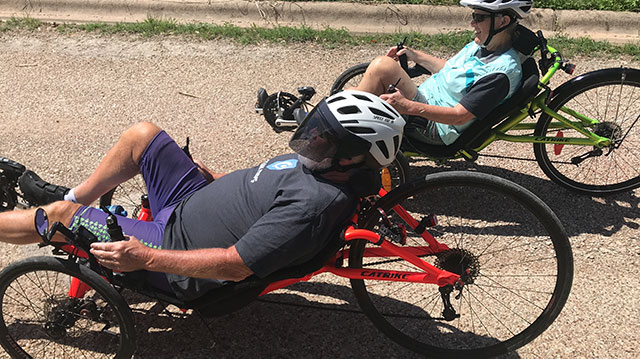Exercise for Physical and Mental Health
May is Mental Health Month so what better time is there to assess your mind-body-spirit health routines?
Are you getting any exercise? How are you doing with sleep? Are you practicing positive mental health behaviors such as effective stress management, open lines of communication, and a strong social network (despite current “social distancing”)?1
Choose to move
We have all heard that exercise is good for us. Most adults know the various types of exercise, how often to work out, and how hard to work while exercising (FITT principles).2 It is recommended to seek your doctor’s approval to begin exercise if you have been sedentary or recovering from an injury or operation.
Choosing to move may well be your first step while others may increase exercise or add habits that are especially good for mental health. Ask someone to work out with you if you talk yourself out of exercise more often than not.

Know the physical and mental benefits
In case there is uncertainty about why to exercise, the general benefits of regular physical exercise are many: weight management, lower blood pressure, lower blood cholesterol, improved sleep, stress relief, and less risk of developing type 2 diabetes and/or osteoporosis.
Exercise is also linked to improving one’s mood, increasing mental alertness and is considered neuroprotective, which means it helps promote brain health as we age.3,4,5 The Physical Activity Guidelines for Americans were updated to include ‘brain health benefits’ in the list of evidence-based benefits of physical activity.4
Make exercise personal
Select at least one type of aerobic exercise that you like and can do: walk, jog, cycle, swim, mow, dance, or join a group exercise like boxing or Zumba. To avoid over injury or boredom you may cross-train, which simply means you perform two or more types of aerobic exercise each week. You might walk Monday, Wednesday, Friday, and participate in a group cardio class Tuesday and Thursday. Mow on Saturday and garden on Sunday.2,3

Performing combinations of these activities most days of the week can reduce anxiety or depression while building confidence and self-satisfaction. This is due to the increased blood circulation to the brain and the body’s positive reaction to the good stress of exercise.3 How is that for win-win?3,5
Most persons benefit even more by combining aerobic exercise and strength (resistance) training. In this case, you could perform aerobic exercise on Monday, Wednesday, and Friday. Perform strength exercise on Tuesday, Thursday, and Saturday. Remember that many activities of daily living, such as mowing, gardening, carrying groceries (cat litter, pet food), and vacuuming contribute to a well-rounded fitness routine.2
But I have Parkinson’s
What does all of this mean for persons with neurodegenerative diseases, including Parkinson’s?
If only regular exercise over many years would guarantee the prevention of Parkinson’s, right? An exercise lifestyle may well delay the diagnosis or have a positive impact on the initial severity and progression of the disease. It is important that persons with Parkinson’s (PwP) know that exercise is as good for them as for the general population for the many benefits mentioned previously. More good news is that daily exercise contributes to improving not only one’s overall quality of life and wellness but also one’s mental well-being.4,5
Regular exercise before and after a Parkinson’s diagnosis can also maintain (or improve) executive function and cognition.2,5 Good eating and sleeping habits further enhance personal wellness.
If PwP are not convinced to exercise for the general health benefits, then maybe highlighting the mental health benefits will get them off the couch. A professional or a team of professionals (physical therapist, dietitian, counselor, personal trainer) can connect health care, nutrition, and exercise for a person with Parkinson’s in order to write a diet and exercise treatment plan intended to develop healthful routines.1,4,5
The wellness benefits of sleep
“Sleep? What is that?” Whether it is Parkinson’s, side effects of medicine, poor sleep hygiene, or something else, many PwP will affirm that lack of sleep is a serious problem. You might have trouble with daytime sleepiness, falling asleep, waking often, or waking very early and not being able to return to sleep among other sleep issues.
Some things to look at are the timing of carbidopa-levodopa before bedtime, natural sleep aids like melatonin, or prescription drugs. Inform your doctor early and as often as necessary to get help with lack of sleep.
Bottom line: exercise can lead to improved sleep so consider fitting in regular exercise because of that.4
Try wearable technology (Fitbit, Apple Watch) to be informed of the bedtime hours you are restless, asleep, and awake. This information could help you experiment with your sleep patterns such as going to bed later in order to sleep longer. Just as you should ask your doctor for medical clearance to exercise, you might ask your doctor, a sleep specialist, or other professional before spending money on tests or technology that may not help you.
Depression, anxiety, and apathy are familiar to many PwP. Poor sleep can impact both mental and physical health. Exercise contributes to better sleep. Sleeping well contributes to improved mood, which eliminates or reduces the risk of depression. So, it seems logical to say that exercise helps reduce the risk of developing depression and its possible cohorts.4,5
Your 24 hours
Daily routines help set a positive tone for mental health. Waking near the same time each day, making your bed, taking care of pets, calling or emailing a friend, praying or meditating for ten minutes, cleaning one room, exercising for 30-60 minutes, and tending to family matters before going to bed near the same time each night are examples of routine components that bring satisfaction and comfort. Those who are employed include their hours at work.
While studying how you spend your day, it is a good idea to track daily screen time and time spent socializing with others each day for one week. If you average three hours a day on screens and 30 minutes in social connections (work is not social), then you want to reduce screen time in order to strengthen connections with others.1

Connect your health care dots!
You can always argue that more studies are needed to prove to you that exercise has a good effect on physical and mental health, whether or not you have Parkinson’s. Think about this: practicing daily exercise and other wellness routines will help you study a person who is very important to your family and friends – you!
Stop making excuses and grow excited for the physical and mental benefits of daily exercise. This goes for care partners, too.

Join the conversation